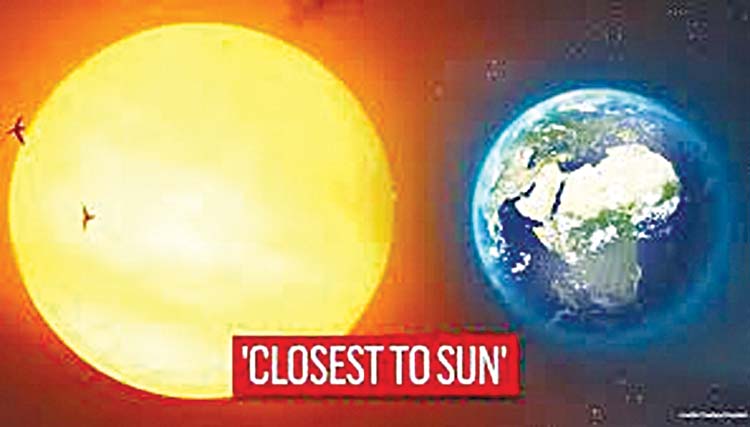Hyderabad, Jan 3 (FN Agency) Planet Earth will reach the closest point to Sun on Wednesday night, Planetary Society of India (PSI) said on Tuesday. Planet Earth will reach the closest point to Sun in its annual elliptical orbit at 0.98329AU i.e. at 14,70,98,928 km from Sun at 9.44 pm tomorrow night, PSI Director N Sri Raghunandan Kumar said in a release. He said Earth revolves around the Sun in an elliptical orbit. Due to which at one point of time Earth will closest it can get to Sun and also farthest it can get during the year. Astronomically this phenomenon is known as “Perihelion”. Whereas on July 7, 2023 at 01:16 am Earth will be at Aphelion at 1.016AU (15,20,93,253km) from Sun i.e.which is the farthest point from Sun. In other words, due to the celestial event of Perihelion on January 4, Earth will be 49,94,325 km closer to the Sun compared to July 7, 2023 in its orbit. Commonly it is believed that the distance of Earth to the Sun decides the season or temperature on Earth. However, it is not true.
Axial tilt (approx. 23.5 Degree) of Earth on its axis while revolving around the Sun regulates seasons on planet Earth with one of the Hemisphere facing away or towards the Sun, Kumar explained. He said at the beginning of the year in every January Month it is winter in most of the countries in the Northern Hemisphere. Whereas Earth is at closest it can get to the Sun at the beginning of the year 2023. Whereas it’s summer in Southern Hemisphere countries. Also in July when Earth is at the farthest point from the Sun it’s mostly hot in India & neighbourhood compared to what it is in January. This clearly shows Distance of Earth to Sun doesn’t decide the Season but its tilt during its yearly journey around Sun. The PSI Director said It’s a fact that Earth takes 365.25 days to complete one revolution around Sun. Compared to Earth, Planet Jupiter takes 11.862 years i.e. 4,332.59 Earth days to complete one revolution around Sun. Just like Earth even Jupiter also at one point in its revolution will be closer (perihelion) and farther (aphelion) from Sun. Thus on January 20, 2023, Planet Jupiter will be at Perihelion (Closest Point) to Sun, Kumar said, whereas Jupiter will be at Apehelion (Farthest Point) to Sun on December 28, 2028.
The last time Jupiter was at Perihelion (Closest point) to Sun was on March 17, 2011. Interestingly though like other planets orbit of Jupiter around Sun is elliptical. It is very close to circular. Hence there is around 10.2% of difference in distances when Planet Jupiter is at perihelion or aphelion from Sun. Though Jupiter is at its closest to Sun on January 20, Jupiter however at present is not closest point to Earth. Because Jupiter closest approach to Earth occurred on September 27, 2022. This Closest approach of Jupiter to Earth occurred due to once in every 13 months celestial event called “Jupiter Opposition”. The PSI Director said on the day of occurance of Perihelion though people will not be able to notice or observe anything significant involving these two celestial events in January. It holds greater education value and scientific awareness. Importantly people can understand that temperatures or Seasons on Earth are not dependent on the distance of Earth to the Sun but axial tilt during its journey around the Sun.

